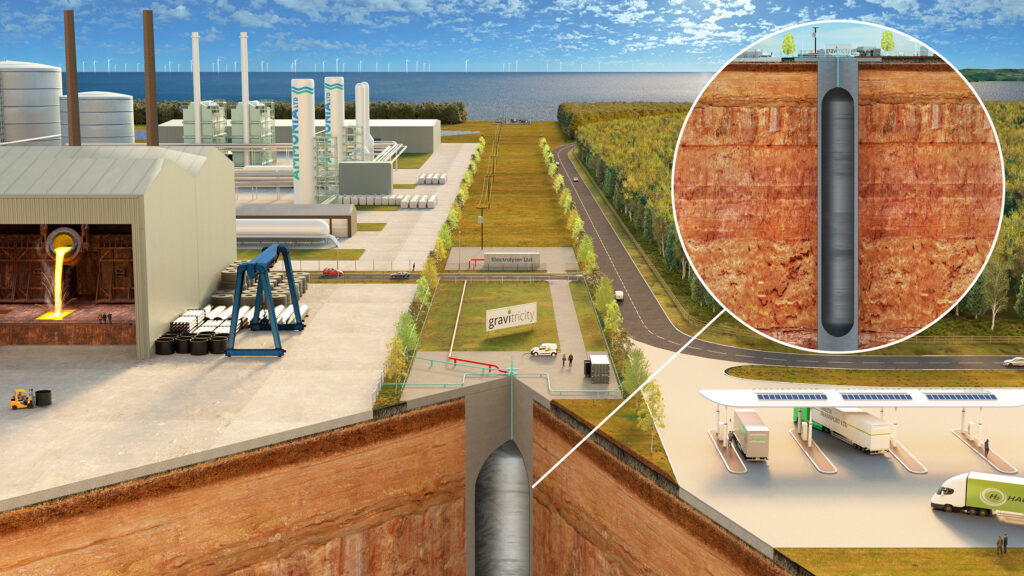Energy storage firm Gravitricity has signed a memorandum of understanding (MoU) with infrastructure company VSL Systems UK to explore purpose-built underground green hydrogen storage.
Gravitricity’s energy storage solution works by raising weights in a deep shaft – with disused mine shafts in particular being targeted by the firm – and releasing them when energy is required. Surplus renewable energy generation is expected to be predominantly used to lift the weights, reducing the need for curtailment and allowing that power to be stored for later grid requirements.
This new partnership opens up the potential for storing green hydrogen at these sites as well, helping to develop the UK’s hydrogen economy and bolster the necessary storage required.
Gravitricity’s solution, dubbed FlexiStore, could provide an alternative form of large-scale hydrogen storage, with the firm having stated that it is more flexible than subterranean salt caverns given the lack of geographical specificity needed.
The company submitted a patent for turning its purpose-built shafts into pressurised energy stores for both hydrogen and heat storage in 2021, building on its previous gravity storage solution.
Within FlexiStore, each rock shaft would be six metres in diameter, 365 metres deep and lined with steel. A single store would be capable of holding up to 100 tonnes of green hydrogen.
“Purpose-built lined rock shafts will be the safest and most affordable way to store large volumes of hydrogen near to where it will be required. It is difficult to transport hydrogen. It therefore makes sense to locate hydrogen storage systems close to sources of renewable power – which can generate green hydrogen – and to potential users,” said Charlie Blair, managing director of Gravitricity.
“At present, the main proposals for storage are underground salt caverns and above ground storage. Salt caverns offer scale, but very little flexibility – they only exist in certain locations; whilst above ground systems lack scale.
“We believe we have a ‘goldilocks’ solution which can be delivered safely and affordably to meet the growing hydrogen economy’s needs.”
Single or multiple FlexiStores could be built close to renewable-powered green hydrogen production facilities, aiding the development of hydrogen-powered industrial hubs and commercial filling stations. This could reduce the price of green hydrogen, by reducing transportation costs.
“VSL is delighted to partner with Gravitricity to develop and deliver these pioneering ground engineering solutions for renewable energy generation and storage. This project is fully aligned with the VSL vision to focus our engineering capabilities and solutions on the global transition to a low carbon future,” said Peter Hughes, managing director of VSL UK.
The need to expand the hydrogen industry and its storage capabilities could be a fundamental development required for the UK to reach its net zero goals by 2050.
In certain sectors, it is thought electricity will not be enough to decarbonise. Hard-to-abate sectors such as heavy industry, steel production, transportation and heating, among others, all fall under this bracket. Green hydrogen is showing itself to be a more promising technology that enables the cost-effective decarbonisation of these industries.
Gravitricity has identified a number of sites for the UK pilot project and is in discussion with site owners, including utilities, regarding the pilot project and future commercial schemes. The two companies are now seeking funds to create the first scale demonstrator project in the UK and, once this has been completed, it hopes to release green hydrogen FlexiStores nationwide.
This follows Gravitricity running a successful a 250kW demonstrator in Edinburgh in 2021, proving the novel technology’s capability. Following this, it secured project support led by the European Investment Bank for its plans to build a full scale 4-8MW project in a former mine shaft in 2022.





